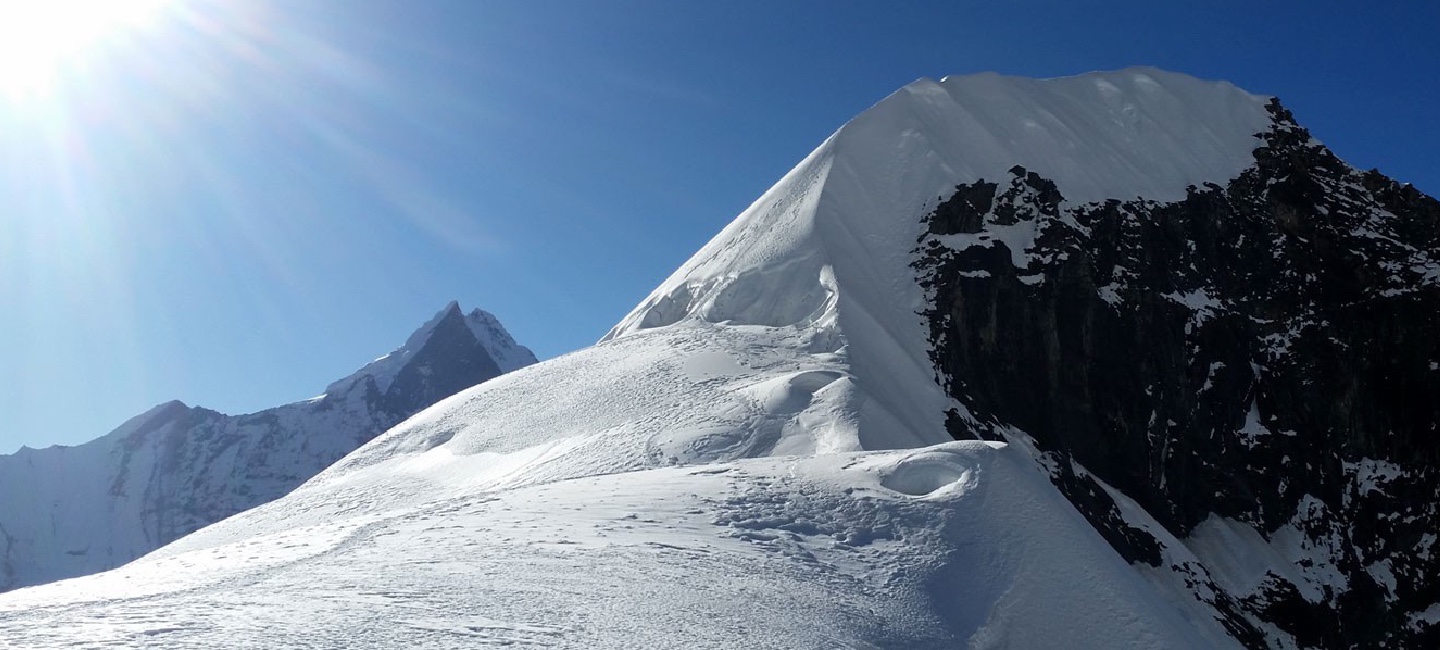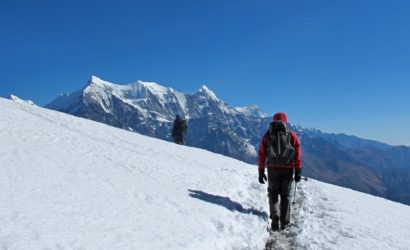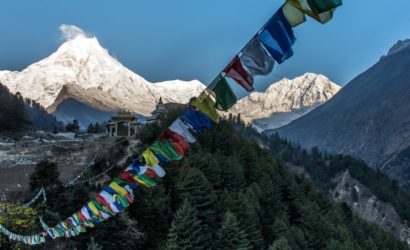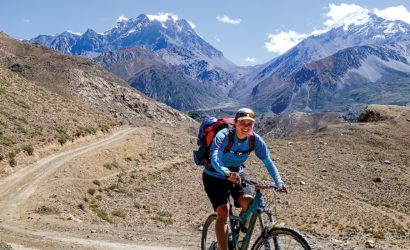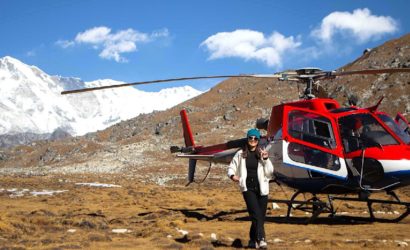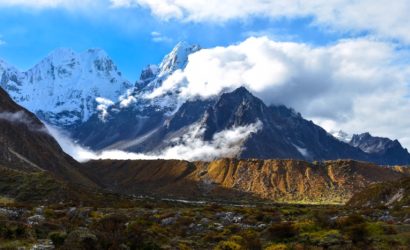Tent Peak known as Tharpu Chuli is situated in the heart of Annapurna Sanctuary at an elevation of 5850 meters. Tent Peak climbing is the perfect opportunity for those who want to summit a Himalayan peak on a smaller scale than all the other peaks.
Along Tent Peak climbing trails, through forests, villages and terraced farmland treating you to unparalleled mountain scenery, giving you an inside experience into the Nepalese life and culture.
An interesting climb combining glacier views, face climbing and tiptoeing on knife ridges, this mountain offers an unparalleled view of the entire Annapurna Sanctuary. A breathtaking circle of hanging glaciers surrounded by some of the highest peaks on earth.
The normal route follows the North-West Ridge to the summit although the mountain has been climbed via the South-East Ridge as well as South-West Face.
The Annapurna Sanctuary refers to an area completely surrounded by a ring of mountains, a natural forest, snow, glacier and moraine amphitheater. Annapurna, Tent Peak is situated in the middle of this area on a ridge that stretches south from Tarke Kang.
Accessing this Tent Peak
The fastest route to the city is by air leaving Pokhara City on a twenty-five-minute flight from Kathmandu. People have been visiting the Annapurna region since the 1960’s and this picturesque mountains region has grown extensively over the past 50 years.
The Annapurna base camp has a wide range of species of animals and birds as well as world famous peaks that people come to see from all over the world. You will receive a warm welcome in the villages as you move up the valley to the base camp of Annapurna.
Recent statistics and research show that an extra day of acclimatization would give you the best chance to make a safe journey into a low-oxygen environment and achieve your ABC Tent Peak goal.
Upon your arrival in the Kathmandu airport after completing your custom formalities Visa, etc. pick up your luggage and look for our airport representative from Himalaya Discovery Adventures, who will display your name on the board at the arrival gate.
You will be greeted by our representative and transferred to your hotel by private tourist vehicle. Overnight in Kathmandu.
Today is free for sightseeing in Kathmandu. You may wish to visit Durbar Square in the heart of the old city where the old Royal Palace, with its intricate woodcarving is located. The whole area is a maze of temples and images. Leading away from the square in all directions are narrow alleys, full of the most amazing variety of shops and stalls.
Some of these landmarks are considered World Heritage Sites including the historic Bhaktapur Durbar Square, the famous ‘Monkey Temple’ Swayambhunath and Buddhists shrine Buddhanath which is one of the largest Stupas in the world.
There will also be a full trip briefing today with gear check. In case you need to hire or buy equipment locally there will be time to do this today. Overnight in Kathmandu.
Trekking staff will arrive at your Hotel at 6:30 am in the morning to pick you up then the bus will leave around 7.30 am to Pokhara.
Pokhara is a beautiful valley, with panoramic views of Annapurna, Machapuchare (shape of fish tail) in the north, Dhaulagiri in the west, Lamjung Himal and Manaslu in the east. The town of Pokhara is set on the banks of the Phewa Lake.
It is smaller and much less hectic than Kathmandu providing the perfect starting point for our trek. Overnight at hotel in Pokhara.
We begin our trek at Nayapul after 1 hour driving by private vehicle from Pokhara. After 15 minutes short walk along the banks of the Modi Khola, we reach Birethanti (1015 meters) a large village that has many shops and teahouses.
From there, the trail continues through the village. The trail follows the north bank of the Bhurungdi Khola. From there, the trail climbs steadily up the side of the valley to Hille at 1495 meters and after the short climb, we reach Tikhedhunga at 1570 meters.
Today’s walk offers a short and relatively easy day, during the journey which allows us to become used to the experience of trekking in Nepal. Overnight at guesthouse.
Leaving Tikhedunga, we begin our journey with a steep climb to Ulleri. Ulleri is a large Magar village at 2070 meters.
The trail then continues to ascend more gently, through fine forests of oak and rhododendrons towards Banthanti at 2250 meters, then we trek towards Nangethanti at 2460 meters. After an hour walk we arrive at Ghorepani at 2840 meters. Overnight at guesthouse.
Today, very early in the morning, we start an hour hiking to Poon Hill at elevation of 3210 meters, a brilliant spectacle; this vantage point provides an unobstructed view of sunrise over the high Himalayas.
There we spend about 1 hour, then returning to Ghorepani we take a hot breakfast at hotel then we trek to Tadapani (2610 meters). Before starting towards Tadapani, we make climb along ridges and through pine and rhododendron forests to Deurali (2960 meters).
After that we descend to the Banthanti, then turning off to Tadapani. Overnight at guesthouse.
The day starts with steep downhill through rhododendron forests. Leaving Tadapani, we descend steeply through forests and then the trail eases as we reach Gurjung which is the village of Gurung people, with an easy walk to Chomrong at elevation of 2140 meters. Overnight at guesthouse.
Today the trail drops down to the Chhomrong Khola and again we continue climbing to Khuldighar at 2380 meters where there used to be an ACAP (Annapurna Conservation Area) Check post.
There is a clearing in the forest a little further on, from there the route goes very steeply down a bank of rock then levelling out, running through thickets of bamboo at the bottom of the gorge, keeping always on the west side of the river. Overnight at guesthouse.
A short walking day today because of altitude and risk of snow avalanches in the area that we need to cross in the next morning. Our day begins with the climb through bamboo, then rhododendron forests to Himalayan Hotel and on to Hinko cave.
The accommodation will be in Deurali, on the ridge above Hinko is the stretch of trail that is most subject to avalanche. Overnight at guesthouse.
Today the trail climbs on past the Machhapuchhre Base Camp, which isn’t really a base camp since climbing the mountain, is not permitted. Since it is totally surrounded by mountains, this area is known as the Annapurna Sanctuary.
Two hours trek from Machhapuchhre Base Camp takes you to the Annapurna Base Camp (ABC) at elevation of 4130 meters. There, you will view unobstructed views of mountain scenery, which is very spectacular. Overnight at guesthouse.
From here we will have short walking day as it is very important to avoid getting affected by the thinning of the air and get acclimatization to climb Tent peak. Our guide will give important and useful information about the situation on climbing Tent peak and about next day’s activities.
From today the accommodation will be tented camp for next two days and you will be having camp food cooked by our professional cook. Overnight at Tented camp.
A short day in order to acclimatize and adjust to the thinning of the air, we take a short trek around high camp and get ready for our adventure for next morning. Overnight at Tented camp.
Today is our main adventure day, an early morning to climb Tent peak but it all depends on the weather. After safe trip to the summit we make our way safely down then day back to Base Camp. Overnight at Tented camp.
We follow the same trail down today the trail drops down by 1200meters to the bank of Modi Khola to small town of Deurali at 3200 meters. Overnight at guesthouse.
We follow the same trail until Chomrong through Himalaya hotel, Dovan, Bamboo. Once we have passed Khuldighar there is an experimental sheep Farm, the trail continues through rhododendron and bamboo fields. Overnight at guesthouse.
The day starts with easy walking and then downhill for an hour. After an hour leaving Chomrong, we descend steeply through forests and then the field to Kumrong Khola.
From here we go up which takes you to the Kumrong Danda then a 45 minute gentle down to Ghandruk.
Ghandruk is the village of Gurung people, one of the ethnic groups of Nepal, have their own dialect, typical culture, costume, and life style.
This village is possibly the popular tourist destination that offers the beautiful mountain views and having easy connection with Pokhara or Kathmandu. We will have small sightseeing around the village. Overnight at guesthouse.
From Ghandruk, we walk at the right side of Modi Khola for 5 hours to Birethanti which is considered one of the best and relaxing walk of the entire trek.
We reach Nayapul then an hour drive will take us back to Pokhara. Overnight at hotel.
Today is free and relax day. Overnight at hotel in Pokahara.
We depart at approximately 7.30 am for Kathmandu by tourist bus. We arrive back in Kathmandu at around 2-3.00 pm. Overnight at in Kathmandu.
Today is rest and relax throughout the day. If you get interested to take some gifts from Nepal for friends and relatives, visit to some nearby shops or go out in Thamel for typical Nepalese goods.
In the evening we will have a farewell dinner in a traditional Nepalese restaurant with cultural performances. Overnight in Kathmandu.
The trip concludes, we will drop you to the airport for your flight departure from Nepal.

